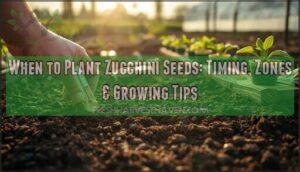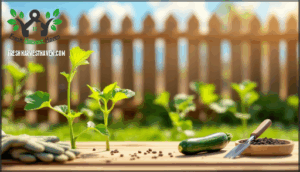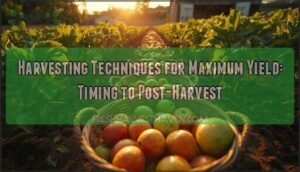This site is supported by our readers. We may earn a commission, at no cost to you, if you purchase through links.

Zucchini demands warm soil, frost-free nights, and precise timing that changes drastically depending on where you live. Getting it right means understanding your local climate, measuring soil temperature instead of guessing, and knowing exactly when your growing zone gives you the green light to plant.
Table Of Contents
- Key Takeaways
- Choosing The Right Time to Plant Zucchini
- When to Plant Zucchini Seeds
- Factors Affecting Zucchini Planting Success
- How to Plant Zucchini Seeds
- Caring for Zucchini After Planting
- Frequently Asked Questions (FAQs)
- How do you plant a zucchini plant?
- Can you grow zucchini from seeds?
- When should I plant zucchini seeds?
- What month do you plant zucchini seeds?
- What should not be planted near zucchini?
- Can I plant zucchini seeds directly in the ground?
- Can I plant zucchini in September?
- Can zucchini seeds be saved from store-bought zucchini?
- How deep should I plant zucchini seeds exactly?
- What companion plants work best with zucchini?
- Conclusion
Key Takeaways
- Plant zucchini seeds when soil reaches 70°F and nighttime temperatures consistently stay above 50°F, at least 2-3 weeks after your last frost date to prevent rot and cold damage that kills tender seedlings.
- Your USDA hardiness zone dictates planting windows dramatically—Zone 3-4 gardeners wait until late May, while Zone 8-10 growers can start as early as March, with microclimates shifting these dates by up to two weeks.
- Succession planting every 2-3 weeks from your last frost date through mid-July delivers continuous harvests from June through October instead of one overwhelming crop, requiring 50-60 frost-free days minimum per planting.
- Direct sow seeds 1 inch deep and 24-36 inches apart once soil warms, or start indoors 2-4 weeks early for cold climates, ensuring consistent moisture and 6.0-7.5 pH soil for germination rates above 90%.
Choosing The Right Time to Plant Zucchini
Timing your zucchini planting right means understanding your local climate, not just following generic calendar dates. Your growing zone, frost schedule, and even your backyard’s unique microclimate all shape when you can safely get seeds in the ground.
Let’s break down the key factors that’ll help you nail the perfect planting window.
USDA Zones and Microclimates
Beyond zone numbers, your garden’s microclimate can make or break your zucchini crop. Regional growing zones provide a baseline, but factors like south-facing slopes, windbreaks, and sheltered spaces create unique pockets of warmth that shift planting windows by weeks. That’s why checking soil temperature directly beats following blanket zone recommendations every time. Understanding microclimate conditions is vital for ideal plant growth and crop success.
- Zone 3-4: Plant after late May once soil temperature consistently reaches 65°F or higher
- Zone 5-7: Begin outdoor sowing mid-April through June when frost danger passes
- Zone 8-10: Start seeds in early March, with succession planting extending through summer months
Last Frost Dates and Local Weather
Your last frost date marks your planting window, but don’t treat averages as gospel. Atlanta’s frost danger usually ends March 17, while Bismarck waits until May 12—a stark contrast driven by USDA zone differences and regional weather patterns.
Microclimates shift these dates by two weeks in either direction, with urban heat islands advancing planting times compared to rural zones. Track 10-day forecasts and measure soil temperature directly since garden-level readings drop 2-4°F below official weather stations, making frost risk assessment vital for protecting tender seedlings.
Understanding frost date basics is essential for determining the best planting time.
| Location | Average Last Frost Date |
|---|---|
| Jacksonville, FL | February 6 |
| Atlanta, GA | March 17 |
| Denver, CO | April 30 |
| Buffalo, NY | May 5 |
| Bismarck, ND | May 12 |
Planning for Spring, Summer, and Fall Crops
Once you’ve mapped your frost dates, the real strategy begins: stacking plantings across spring, summer, and sometimes fall to keep zucchini flowing from your garden for months instead of weeks. Spring crops launch two to three weeks after your last frost date once soil temperature hits 65-70°F, while summer succession plantings every 14-21 days prevent harvest gaps. Your USDA zone dictates fall feasibility—zones 8-10 can push plantings into late August, but colder regions won’t have enough frost-free days.
Boost yields with these tactics:
- Crop rotation prevents soil depletion and disease buildup between plantings
- Harvest scheduling every 2-3 weeks maintains continuous production through October
- Seasonal varieties perform differently—summer types tolerate heat; fall crops need shorter maturity windows
- Garden planning with soil preparation between cycles replenishes nutrients and controls pest pressure
When to Plant Zucchini Seeds
Now that you know the broad strokes of planting timing, let’s get specific about when you should actually put those zucchini seeds in the ground.
Your success hinges on three key factors: your hardiness zone, the soil temperature at planting depth, and how you schedule successive plantings for a steady harvest all season long.
Best Planting Dates by Zone
Your USDA zones and frost dates determine when you can safely plant. In zone 3, direct sowing starts around May 15, with transplants going out May 30—two weeks after the last frost date. Warmer zones get an earlier jump: zones 8a and 8b can sow outdoors around March 15, while zones 9a and 9b begin as early as January 15 to February 15.
Here’s your zone-specific timing:
- Zones 3-4: Direct sow May 15-June 10 when soil hits 70°F
- Zones 5-7: Start mid-April through June for succession planting
- Zones 8-11: Begin early March with multiple plantings through spring
Weather patterns shift these windows, so watch for unexpected cold snaps that threaten frost protection efforts.
Soil and Air Temperature Requirements
At 70°F soil temperature, your zucchini seeds hit their ideal range—anything below 60°F slows sprouting and invites rot. Use a soil thermometer at 2-inch depth to measure thermal zones before sowing, because guesswork costs you control.
Air temperature matters just as much: daytime readings between 70-85°F drive vigorous growth, while nights below 50°F after your last frost date trigger cold stress and weak fruit set.
Proper climate control through soil preparation and frost danger awareness puts you firmly in charge of germination rates and harvest success.
Timing for Continuous Harvests
If you want zucchini on your table from June through October, succession planting is your most powerful tool—and it’s simpler than you might think. Stagger new sowings every 2-3 weeks from your last frost date through mid-July to maintain continuous harvests without overwhelming yield spikes.
Here’s your harvest scheduling strategy:
- First planting: Sow when soil reaches 70°F for ideal zucchini seed germination
- Second round: Plant 14-21 days later to extend your harvest window
- Summer succession: Continue through July for fall crops, rotating beds to reduce disease
- Season extension: Deploy row covers to push past early frost danger
This crop rotation approach delivers yield maximization while keeping your harvest manageable.
Factors Affecting Zucchini Planting Success
You won’t get a strong harvest if you ignore the basics—zucchini demands specific conditions to thrive, and skipping even one can tank your entire crop. Cold temperatures, frost exposure, and poor soil preparation create immediate problems that stop seeds from germinating or stunt young plants before they ever produce fruit.
Let’s break down the three critical factors that make or break your zucchini planting success.
Zucchini’s Sensitivity to Cold and Frost
Cold weather is zucchini’s worst enemy—and underestimating its vulnerability can destroy your entire crop before it even starts. When temperatures plunge to 32°F, frost damage kills seedlings instantly, blackening tender leaves and collapsing cell walls as water freezes inside plant tissues. Even without visible frost, chilling injury strikes between 41-50°F, reducing your yields substantially and stunting growth. You’ll spot pale, wilted foliage within hours, signaling permanent damage.
That’s why tracking your last frost date matters—plant too early, and freeze damage wipes out weeks of work. Once soil temperature drops below 50°F, zucchini stops developing normally.
The solution? Wait until nighttime lows consistently stay above 50°F, use frost protection methods like row covers during cold snaps, and prioritize cold hardiness when selecting planting dates to safeguard your harvest.
Required Frost-Free Days
Zucchini plants don’t just need warm weather—they need enough of it, and that clock starts ticking the moment you plant those seeds. You’ll need at least 50-60 frost-free days from germination to harvest, which means tracking your last frost date isn’t optional—it’s survival. Cold snap events can ambush even careful planners, wiping out weeks of effort in a single night when frost strikes unexpectedly.
Here’s what dictates your success:
- Standard varieties require 50-60 consecutive frost-free days minimum for complete harvest
- Northern climate zones often provide only 60-90 frost-free periods annually, limiting your window
- Germination timing must align with temperature thresholds—soil warming to 70°F triggers growth
- Frost protection methods become essential when nighttime temperatures approach 50°F
- Frost risk remains real even with brief exposure below 35°F, damaging tender seedlings
Calculate your planting date backward from your first expected fall frost to guarantee adequate growing time.
Impact of Soil Warmth and Moisture
Your soil’s warmth and moisture levels are critical factors in determining whether zucchini seeds will thrive or fail. Soil temperature must reach at least 70°F for reliable seed germination, as temperatures below 60°F can stall growth and increase the risk of rot. Moisture levels are equally important: consistently damp (but not waterlogged) soil promotes germination rates above 90%, while erratic watering can destroy seeds before they have a chance to sprout. Testing your soil composition and water retention before planting is essential, as poor soil health can lead to wasted effort.
| Soil Factor | Ideal Condition |
|---|---|
| Soil Temperature | 70-85°F consistently for 5+ days |
| Moisture Levels | Evenly moist, well-draining soil |
| Soil Preparation | pH 6.0-7.5, loose to 12 inches deep |
How to Plant Zucchini Seeds
You’ve got your timing down—now it’s time to get those seeds in the ground. Whether you’re starting indoors for a head start or sowing directly into warm soil, the method you choose can make or break your harvest.
Here’s how to plant zucchini seeds the right way, from depth and spacing to protecting young seedlings from late-season surprises.
Direct Sowing Vs. Indoor Starting
Choosing between direct sowing and indoor seed starting can make or break your zucchini harvest, especially if you’re working against unpredictable spring weather. Direct seeding works perfectly in zones 7 and warmer, where soil temperatures consistently hit 70°F, but indoor seed sowing gives you control over seed germination rates and transplant timing in colder regions.
- Direct seeding: Plant zucchini seeds outdoors once soil reaches 70°F for 70-80% germination
- Indoor seed starting: Begin 2-4 weeks before last frost for 90% success rates
- Sowing depths: Use 1-inch depth regardless of method to prevent transplant shock
- Soil preparation: Warm indoor soil speeds germination by 5-7 days
- Indoor lighting: Provides seedlings strength before outdoor shift
Seed Depth and Spacing Guidelines
Getting your seed placement and plant spacing right from the start sets up your zucchini for healthy growth and maximum production. Plant zucchini seeds one inch deep in soil that’s reached 70°F—this depth protects seeds while allowing quick emergence. Space your seeds 12-18 inches apart within rows, with row spacing of 3-6 feet to prevent overcrowding. You can also use seed sowing methods like hill planting, placing 3-4 seeds per mound.
Proper soil preparation and adequate plant staggering improve germination rates and reduce disease pressure that kills yields.
Tips for Transplanting Seedlings
Once you’ve nailed seed depth and spacing, it’s time to master the art of moving those seedlings outdoors without shocking them into a growth stall. Transplant shock happens when roots can’t adapt quickly enough to new conditions, so seedling hardening is your best defense. Start by exposing seedlings to outdoor conditions for one week before the final transplant.
Here’s how to secure strong root development:
- Wait until nighttime temperatures stay above 50°F consistently
- Manage seedlings by their leaves, never the fragile stems
- Plant at the same depth they grew in seed starting containers
- Water immediately after transplanting to support soil acclimation
- Choose transplant over direct seeding in zones 3-6 for better control
Proper seedling care during this shift determines whether your plants thrive or struggle all season.
Using Mulch and Row Covers for Protection
Right after your seedlings settle into their new home, it’s time to lock in that protection with mulch and row covers. Spread a two-inch layer of organic mulch around each plant for soil insulation and weed suppression—this keeps soil temperature steady while choking out competition. Floating row covers offer frost protection when temperatures dip unexpectedly, creating a warmer microclimate that extends your growing season.
The mulch benefits don’t stop there: consistent moisture retention means less watering stress, and decomposing materials improve soil structure over time, giving your zucchini the upper hand against environmental challenges.
Caring for Zucchini After Planting
Once your zucchini seeds sprout and seedlings establish themselves, the real work begins—keeping them healthy, productive, and pest-free through the growing season. Success depends on getting the basics right: soil quality, consistent watering, structural support, and timely pest management.
Here’s what you need to focus on to boost your harvest and keep those plants thriving until frost.
Soil Preparation and PH Levels
Think of your soil as the engine that powers every zucchini on your plant—if the pH is off or nutrients are lacking, even perfect watering won’t save your harvest. Start your soil preparation by testing pH levels—you’re aiming for 6.0 to 7.5, where nutrient cycling works best.
Work in three to four inches of compost to improve garden soil structure and support microbe management. If soil conditions test acidic, add lime; for alkaline soil, apply sulfur.
Check soil temperature too—warm soil preparation for planting means better root development and stronger nutrient uptake throughout the season.
Watering and Fertilizing Best Practices
Consistently delivering 1-2 inches of water weekly through proper irrigation scheduling protects your plants from water stress that can slash yields by up to 40%. You’ll want to water deeply once or twice per week, reaching 6-8 inches down to encourage sturdy root systems and efficient nutrient uptake. During flowering and fruiting, increase watering frequency to every 2-3 days when heat intensifies. Pair this with balanced fertilizer types like 10-10-10 NPK applied at planting and again when flowers appear.
- Check soil moisture at 2-3 inches depth before watering—dry soil signals it’s time
- Apply 2-3 inches of organic mulch to maintain soil moisture and reduce irrigation needs
- Use drip irrigation or soaker hoses for root-level watering and disease prevention
- Feed with liquid fertilizer every 2-3 weeks during active growth for continuous nutrient uptake
Supporting Plants and Preventing Pests
Protecting your zucchini from pests and structural stress isn’t just good practice—it’s the difference between a thriving garden and a disappointing harvest. Installing 6-foot plant stakes improves airflow and cuts disease risk by 60%, while row covers block squash bugs and vine borers until pollination begins.
Companion planting with marigolds and basil provides natural pest control, and regular crop monitoring catches infestations early.
Apply mulch for soil aeration and weed suppression, and practice crop rotation to maintain a balanced ecosystem that fosters disease prevention and healthy fruit management throughout the growing season.
Planning for Harvest and Storage
You’ll usually be harvesting zucchini just 30 to 50 days after planting, so understanding proper storage techniques now prevents waste and maximizes your garden’s yield later. Harvest scheduling requires daily plant checks once fruiting begins—pick zucchinis at 6-8 inches for ideal flavor and texture. Morning harvesting techniques work best when plants are cool and hydrated, improving post-harvest management outcomes.
Smart storage methods and continuous harvests depend on these zucchini harvest tips:
- Store unwashed fruits in perforated plastic bags in your refrigerator’s crisper for up to one week
- Save seeds from fully mature fruits (10-12 inches) for next season’s crop rotation
- Use proper fruit storage by avoiding bruising during harvest—cuts shorten shelf life dramatically
- Plan season extension with succession planting every two weeks for ongoing production through fall
Frequently Asked Questions (FAQs)
How do you plant a zucchini plant?
Starting zucchini seems backward—these heat-lovers actually need cold timing first.
Sow your zucchini seeds one inch deep in warm soil (70°F) after frost passes, spacing them 2-3 feet apart for proper garden layout and airflow.
Can you grow zucchini from seeds?
Absolutely—zucchini seeds germinate readily when you provide the right conditions. Direct sow them 1 inch deep once your soil warms to 70°F, or start seeds indoors 2-4 weeks early to jumpstart seed germination and extend your growing season for various zucchini varieties.
When should I plant zucchini seeds?
Your garden’s soil thermometer hits that magical 70°F ideal point—that’s your green light.
Plant zucchini seeds 2-3 weeks after the last frost date, once nighttime temps stay above 50°F and soil temperature remains consistently warm for reliable seed germination across all zucchini varieties.
What month do you plant zucchini seeds?
Most zones call for planting zucchini seeds in May or June, once soil temperature hits 70°F and your last frost date passes.
Zone 3-4 gardeners wait until late May, while Zone 8-10 growers can start as early as March for succession planting throughout the growing season.
What should not be planted near zucchini?
Keep vining crops—cucumbers, melons, and other squash—away from your zucchini to prevent plant competition for nutrients and space.
Fennel disrupts growth and attracts garden pests, while companion planting with beneficial insects and proper crop rotation reduces soil contamination and aids pest and disease management.
Can I plant zucchini seeds directly in the ground?
Like your grandfather’s victory garden, direct seeding zucchini works beautifully when conditions align. Plant seeds one inch deep in 70°F soil, spacing them 24-36 inches apart after your last frost date passes, and you’ll develop sturdy plants with stronger root systems than transplants.
Can I plant zucchini in September?
In zones 8-11, September sowing can work if you’ve got 60+ frost-free days remaining. Your first frost date dictates success—zucchini needs 35-45 days to mature before cold weather arrives.
Late season planting works best with fast-maturing zucchini varieties suited for cool weather and shorter growing seasons.
Can zucchini seeds be saved from store-bought zucchini?
You can’t reliably save seeds from store-bought zucchini. Most commercial varieties are hybrids, meaning they won’t produce true-to-type plants—your germination rates will be unpredictable.
For successful seed saving, grow heirloom varieties instead, which offer consistent seed viability and protection from unwanted cross-pollination effects.
How deep should I plant zucchini seeds exactly?
Your seed depth directly impacts germination speed—plant zucchini seeds exactly 1 inch deep into well-prepared soil. This planting technique places seeds where they’ll access consistent moisture while allowing seedlings to emerge within 5-7 days, provided soil temperatures reach 70°F for ideal zucchini germination and strong seedling care.
What companion plants work best with zucchini?
You’ll want to pair your zucchini seeds with beans, corn, and radishes—they create natural garden partnerships through companion planting. Nasturtiums repel pests effectively, while marigolds add protection and visual appeal.
Skip potatoes; they compete for nutrients and complicate crop rotation planning.
Conclusion
Think of zucchini seeds as travelers waiting for the perfect departure window—launch too early into freezing conditions and they’ll perish, wait too long and you’ll miss your harvest season entirely.
When you plant zucchini seeds at precisely the right moment, when soil hits 60°F and frost has truly passed, you’re not gambling—you’re commanding your garden’s success.
Check your zone, measure that soil temperature with a thermometer, and plant with confidence, knowing you’ve stacked every advantage in your favor for prolific summer squash.




